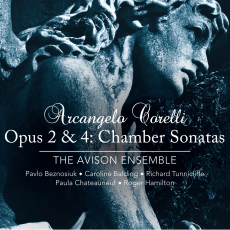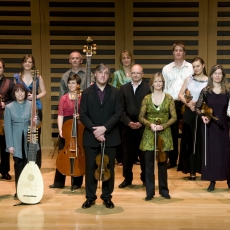The Avison Ensemble - Corelli: Opus 2 & 4: Chamber Sonatas - Gramophone
The Avison Ensemble continue their stunning Corelli anniversary recording project with two of the less-often-recorded opuses, the sonate da camera. These performances occupy fresh ground - intimately styled and seemingly less obviously inspired by public performance than previous recordings. The two collections, published in Rome in 1685 and 1694, set the standard for the flowering of trio sonatas throughout Europe that followed. Miniature in scale, each movement is finely crafted - no doubt performed may times before being made available to the public in final form. Corelli was nothing if not a perfectionist.
Pavlo Beznosiuk and The Avison Ensemble have clearly given much thought and attention to their performances: beautifully understated, and allowing the music to speak for itself.
The tempi are relaxed without compromising a sense of line, imparting instead a breadth that suggests to us an expression of Corelli's life and times (the Avison's 'Ciaconna, Op.2 No 12', is 48 seconds longer than that of the Purcell Quartet's- Chandos, 6/92). Certainly for the duration of many tracks - the Preludes of O.p 4 Nos. 5 and 9, for example - past and present seem to merge.
Perhaps the most striking feature of this recording is The Avison's careful attention to ensemble textures and timbres. Others before them have experimented with the continuo forces but rarely with such effect. Paula Chateauneuf's archlute solo accompaniments contribute enormously to the intimacy and stylishness of the recording (Op. 2 No. 6's 'Corrente' and Op. 4 No. 7's 'Grave'), and add gentle percussion when appropriate (Op. 2 No. 11's closing 'Giga'). Even better, though, are the tracks with cello and archlute, which include the second and fourth sonatas and the final 'Ciaccona' of Op. 2.
Walking and running Basses, though, are best allocated to the cello. Richard Tunnicliffe's solo cello accompaniments enable a homogeneous bowed string sound, as in Op. 2 No. 5 and Op. 4 No. 8, which in its simplicity sounds almost modern. More often the cello combines with harpsichord or organ (the 'Prelude' of Op. 4 No. 4 is a jewel), providing a firm bass for the suspensions between the violins (the first two movements of Op. 2 No. 7) and freeing the cello to participate in points of imitation with the violins (the 'Corrente' of Op. 4 No. 1).
We look forward to the imminent release of Opp. 1 and 3.

